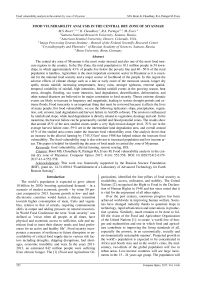Food vulnerability analysis in the central dry zone of Myanmar
Автор: Boori Mukesh Singh, Choudhary Komal, Paringer Rustam Aleksandrovich, Evers Mariele
Журнал: Компьютерная оптика @computer-optics
Рубрика: Image processing, pattern recognition
Статья в выпуске: 4 т.41, 2017 года.
Бесплатный доступ
The central dry zone of Myanmar is the most water stressed and also one of the most food insecure regions in the country. In the Dry Zone, the total population is 10.1 million people in 54 townships, in which approximately 43 % of people live below the poverty line and 40 - 50 % of the rural population is landless. Agriculture is the most important economic sector in Myanmar as it is essential for the national food security and a major source of livelihood of the people. In this region the adverse effects of climate change such as a late or early onset of the monsoon season, longer dry spells, erratic rainfall, increasing temperatures, heavy rains, stronger typhoons, extreme spatial-temporal variability of rainfall, high intensities, limited rainfall events in the growing season, heat stress, drought, flooding, sea water intrusion, land degradation, desertification, deforestation, and other natural disasters are believed to be major constraints to food security. Theses extreme climatic events are likely to increase in frequency and magnitude, leading to serious drought periods and extreme floods. Food insecurity is an important thing that must be reviewed because it affects the lives of many people. For food vulnerability, we use the following indicators: slope, precipitation, vegetation, soil, erosion, land degradation and harvest failure in ArcGIS software. The erosion is influenced by rainfall and slope, while land degradation is directly related to vegetation, drainage and soil. In the meantime, the harvest failure can be generated by rainfall and flood potential zones. The results show that around 45 % of the area studied comes under a very high erosion danger level, 70 % are in the average harvest failure zone, 59 % are in the intermediate land degradation area, and overall around 45 % of the studied area comes under the insecure food vulnerability zone. Our analysis shows that an increase in the alluvial farming by 1745.33 km2 since 1988 has helped reduce the insecure food vulnerability. The food vulnerability map is also relevant to increased population and low income areas. This paper is helpful for identifying the areas of food needs in central dry zone of Myanmar.
Food vulnerability, alluvial farming, remote sensing, gis
Короткий адрес: https://sciup.org/140228766
IDR: 140228766 | DOI: 10.18287/2412-6179-2017-41-4-552-558
Текст научной статьи Food vulnerability analysis in the central dry zone of Myanmar
The world’s population is expected to grow almost 10 billion by 2050, boosting agricultural demand – in a scenario of modest economic growth – by some 50 percent compared to 2013. Income growth in low- and middle-income countries would hasten a dietary transition towards higher consumption of meat, fruits and vegetables, relative to that of cereals, requiring commensurate shifts in output and adding pressure on natural resources. In World Food Conference the term "food security" was defined as "exists when all people, at all times, have physical and economic access to sufficient, safe and nutritious food to meet their dietary needs and food preferences for an active and healthy life". Food security incorporates a measure of resilience to future disruption or unavailability of critical food supply due to various risk factors including droughts, shipping disruptions, fuel shortages, economic instability and wars. In the years 20112013, an estimated 842 million people were suffering from chronic hunger. The [1] (Food and Agriculture Or- ganization), identified the four pillars of food security as availability, access, utilization, and stability. The United Nations [2] recognized the Right to Food in the Declaration of Human Rights in 1948 and has since noted that it is vital for the enjoyment of all other rights.
Over the past century, enormous progress has been achieved worldwide in improving human welfare. Societies have changed radically thanks to quantum leaps in technology, rapid urbanization and innovations in production systems. Similarly, much remains to be done to fulfill the vision of the Food and Agriculture Organization of the United Nations [1]: to create ‘a world free of hunger and malnutrition and one in which food and agriculture contribute to improving the living standards of all, especially the poorest, in an economically, socially and environmentally sustainable manner’. Projected growth in the world’s population is expected to be concentrated in Africa and South Asia and in the world’s cities. By midcentury, two-thirds of the global population will live in urban areas. Low-income countries will see large increments in the 15 –24 years age group. The population will continue to grow in South Asia until mid-century and in sub-Saharan Africa until at least the end of the century. By the year 2100, Asia and Africa are expected be home to a combined population of 9 billion, out of the projected 11 billion people who will inhabit Earth
In Myanmar, 44 percent of households had problems meeting food needs [3] despite being part of a major agricultural region [4]. According to [4], 58 % of those living in the region are farmers and 25 % are farm laborers. Similarly, other studies [5] also indicate that farming and casual labor in the agriculture sector are the two key livelihood activities in the Dry Zone [6]. The vulnerabilities of many farming communities are increasingly complex as Myanmar undergoes unprecedented political, social and environmental changes, making the design of impactful development interventions challenging. Food insecurity and flood risk are very common in the Dry Zone (Fig. 1). A survey conducted by [7] found that 18 % of households had inadequate food for consumption and more than a quarter of children under the age of five were underweight. Households with poor access to land and markets and those relying on casual labor are the most likely to have insufficient food. Farming households are more likely to be food-secure, but food security is precarious even for these families. In 2010, the food security of 41 % of farming households was adversely affected by dry spells [8].
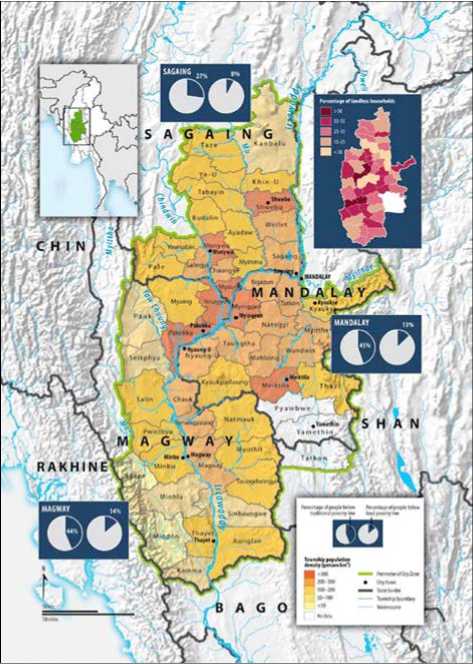
Fig. 1. The demographics of Myanmar's Dry Zone, showing the population density of townships and distribution of landless households. (Source: Boundary/townships as defined by the Myanmar Information Management Unit [MIMU] [Map Id.: MIMU983V01], March 2013 []; Statistics on population density, poverty and landless households from JICA 2010)
Remote sensing and GIS technology can help to access food insecurity through satellite data and socio-economic data such as soil condition/thickness, rate of erosion and har-vest/crop failure. The erosion is directly related to rainfall and slope, which we can get from rainfall stations and elevation map/DEM. Land degradation level is based on vegetation condition, drainage and soil solum thickness. While harvest failure can be generate by rainfall and flood potential zones. With remote sensing technology, the analyst will know the locations that are vulnerable for experiencing food insecurity and it will help the local government to distribute the food needs for the community based on the analysis. Spatial modeling for food insecurity was usually performed using quantitative modeling methods of tiered-overlay where each parameter has a weight for each factor. So that, the greater the value of the factor, the greater the influence to the result. Besides of physical parameter, we also used the social and economic parameters, which are the society’s income information on the population in the study area that is vulnerable to the poverty line [9]. So that the mapping of food insecurity is very helpful for managing equitable distribution of food to the local community needs. The main objective of this research work is (1) build a model for food security through remote sensing and GIS, (2) identify the different levels of food insecurity, (3) identify the different parameters, which used to identify food insecurity, (4) identify most influential factors of food insecurity and (5) identify location distribution of food insecurity in the study area.
Materials and methods
To know the food vulnerability in the study area, we used primary (satellite data) and secondary data such as slope, precipitation, vegetation, soil, erosion, land degradation and harvest failure, ground truth data for land use/cover classes and topographic sheets. The ground truth data were collected using Global Positioning System (GPS) for the year of 2016 in the month of June to August for image analysis and classification accuracy. The specific satellite images used were Landsat 8 OLI (Operational Land Imager) for 2016 [7]. All image processing work were done in ArcGIS software and generate thematic layer (Fig. 2). The whole spatial modeling for food vulnerability was complete in following steps:
Slope map: To generate slope map, we used Digital Elevation Model (DEM), which we get from USGA website . Then the slope was classified according to Table 1 and then gives different weightage according to their sensitivity [8, 9].
Table 1. Classification of slope perameter
|
Class |
Slope (%) |
Weightage |
|
Flat |
<4 |
1 |
|
Slope slightly |
4–12 |
2 |
|
Rather steep |
12–24 |
3 |
|
Steep |
24–40 |
4 |
|
Very steep |
40< |
5 |
Vegetation map: was generated by landsat 8 OLI imagery. First we make Normalized Difference Vegetation Index (NDVI) then classcify image based on color tone. Dark red color show thick vegetation and light tone thin vegetation [8, 9]. The vegetation classification
a)
e)

b)
show in following Table 2 and Fig. 2.


h)

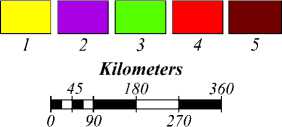
Fig. 2. Thematic layers which used to generate food vulnerability map: a) slope; b) vegetation cover; c) precipitation; d) soil; e) erosion; f) erosion danger level; g) land degradation; h) harvest failure
Table 2. Classification of vegetation cover
|
Class |
Slope (%) |
Weightage |
|
Very bad / thin |
<20 |
1 |
|
Bad / thin |
20–40 |
2 |
|
Average |
40–60 |
3 |
|
Good / thicker |
60–80 |
4 |
|
Very good / thick |
80 < |
5 |
Precipetation map: We get precipetation map from GWSP (Digital Water Atlas with 0.5 degree. For analysis work, first shapefile was convert into raster file with 30×30 m cell size by mean value (Fig. 2). Then mean annual precipetation value were assigned weightage according to Table 3 [8, 9].
Table 3. Classification of annual precipetation
Mean annual precipitation > 15 15–25 25–35 35–50 50<
Weightage 1 2 3 4 5
Soil map: We get soil map from GWSP (Digital Water Atlas with 0.5 degree. For analysis work, first shapefile was convert into raster file with 30×30 m cell size by mean value (Fig. 2). Then soil value were assigned weightage according to Table 4 [8, 9].
Erosion map: We get erosion map from GWSP (Digital Water Atlas with 0.5 degree. For analysis work, first shapefile was convert into raster file with 30×30 m cell size by mean value (Fig. 2). Then erosion value were assigned weightage according to Table 5.
Erosion danger level modeling: We use soil and erosion map (Table 6) for erosion danger level and generate erosion danger level map (Fig. 2) based on Table 7. Around 45 % study area comes under very high erosion danger level (Fig. 3) due to lose soil, sparse vegetation and uncertain rain intensity.
Land degradation modeling: This modeling is based on erosion danger level, vegetation cover and slope. All these parameters have weighted, according to their effec-tiveness/sensitivity. Now in land degradation modeling, vegetation cover parameter weight is 45, erosion danger level is 35 and slope parameter weight is 20.
|
Table 4. Classification of Soil characteristics |
|
|
So Soil characteristics thickness |
Weightage |
|
Yellowish brown regosol and grey grumosol complex, grey regosol, Very thin greyish brown regosol, association |
1 |
|
of litosol and brown mediteran complex Dark grey grumosol, dark grey Thin andosol, association of yellowish |
2 |
|
brown andosol and litosol complex Kambisol, litosol, and renzin, brown mediteran, reddish brown mediteran, verage and reddish brown mediteran, complex latosol and renzina Brown latosol, reddish latosol, Deep complex reddish brown latosol, and |
3 4 |
|
litosol Very deep Greyish brown alluvial |
5 |
|
Table 5. Classification of erosion parameter |
|
|
Class Erosion (ton/ha/year) Weightage |
|
|
Very low <20 |
1 |
|
Low 20–80 |
2 |
|
Average 80–200 |
3 |
|
High 200–450 |
4 |
|
Very high 450< |
5 |
Table 6. Calculation of erosion danger level based on soil thickness and erosion degradation are low vegetation cover, high slope and high erosion rate, which is also increase food vulnerability.
|
Table 8. Classification of land degardation |
||||
|
Class |
score |
Weightage |
Area Km2 |
% |
|
Not critic |
< 100 |
1 |
1025.73 |
1.29 |
|
Critic |
100–200 |
2 |
8615.88 |
10.86 |
|
potentially |
||||
|
Average |
200–300 |
3 |
46472.51 |
58.58 |
|
Critic |
300–400 |
4 |
22954.27 |
28.93 |
|
Very critic |
400 < |
5 |
270.02 |
0.34 |
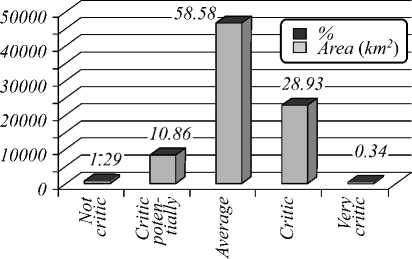
Fig. 4. Graphical representation of land degardation
Harvest failure modeling: This modeling was generated by 3 parameters: 1) Terrain unit, 2) flood risk and 3) vegetation cover. Then it was classified based on its score as follow in Table 9. We find that almost 70 % central dry zone area comes under middle type of harvest failure (Fig. 5); this is also increase high food insecurity.
|
Soil thickness |
Erosion class |
||||
|
1 |
2 |
3 |
4 |
5 |
|
|
5 |
I |
II |
III |
IV |
V |
|
4 |
II |
III |
IV |
V |
V |
|
3 |
III |
IV |
V |
V |
V |
|
2 |
IV |
V |
V |
V |
V |
|
1 |
V |
V |
V |
V |
V |
Table 7. Classification of erosion danger level
Class Erosion danger level Weightage Area Km2 %
|
Very low |
I |
1 |
13670.66 |
16.89 |
|
Low |
II |
2 |
9153.65 |
11.31 |
|
Average |
III |
3 |
11162.35 |
13.79 |
|
High |
IV |
4 |
11072.88 |
13.68 |
|
Very high |
V |
5 |
35878.93 |
44.33 |
5000 00
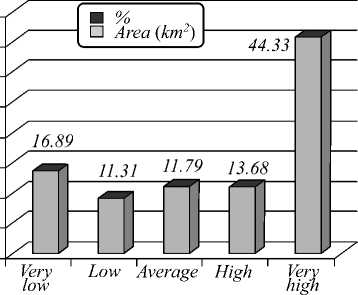
Fig. 3. Graphical representation of erosion danger level
Then the result was classified as Table 8. Analysis shows that around 59 % area under medial type of land degradation (Fig. 4). The influence parameters for land
Table 9. Classification of harvest failure
|
Class |
% harvest failer |
Weightag |
e Area Km2 |
% |
|
Very low |
<2 |
1 |
433.46 |
0.53 |
|
Low |
2–5 |
2 |
14722.05 |
18.14 |
|
Average |
5–10 |
3 |
56787.62 |
69.98 |
|
High |
10–15 |
4 |
8450.45 |
10.41 |
|
Very high |
15 < |
5 |
756.84 |
0.93 |
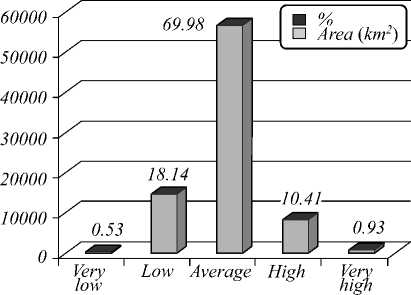
Fig. 5. Graphical representation of harvest failure
Food vulnerability modeling: This is the final modeling. It’s generated by following parameters: vegetation cover, precipitation, land degradation and harvest failure parameter.
Vegetation cover factor (V) =
= 0.007A2 – 1.7109A + 101.53;
Annual precipitation factor (ACH) =
= –0.0078B2 – 2.0304B – 11.424;
Land degradation factor (LD) =
= –0.0242C2 + 3.5117C – 1.4752;
Harvest failure factor (HF) =
= –0.0472D2 + 4.7183D – 6.080.
While A is vegetation cover score, B annual precipitation score, C land degradation score and D harvest failure score. Then, food endurance level will be calculated by following formula [9]:
Food vulnerability (Y) =
= (0.1255×V) + (0.1671×ACH) + (0.2808×LD) +
+ (0.4273×HF).
Analysis shows that 52.60 % central dry zone area under enough of food class but around 45 % study area is under insecure food class area (Table 10 and Fig. 6 b ).
Table 10. Classification of food vulnerability
|
Y |
Explanation |
Area Km2 |
% |
|
<20 |
Very resistance of food |
30.47 |
0.04 |
|
20–40 |
Resistance of food |
3409.64 |
4.20 |
|
40–60 |
Enough of food |
42689.48 |
52.60 |
|
60–80 |
Insecure of food |
31743.87 |
39.11 |
|
80< |
Very insecure of food |
3291.29 |
4.06 |
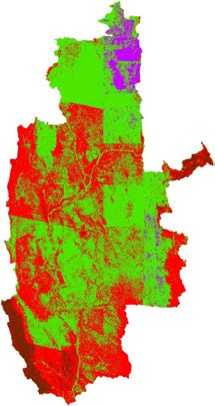
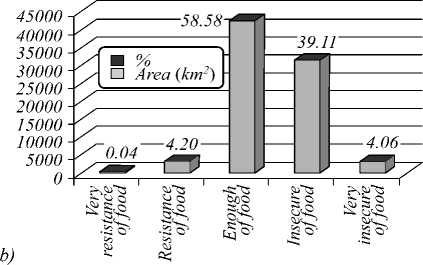
Fig. 6. a) Food vulnerability map; b) graphical representation of food vulnerability map
Results and discussion
The Central Dry Zone is mostly that, with the Irrawaddy River (joined by the Chindwin River), owing through it from north to south (Fig. 1). The Bago Hills range runs parallel to the Irrawaddy River in the southern part of the Dry Zone, gaining altitude towards the north and ending in southeast Mandalay. Fertile alluvial soil is found along the banks of the major rivers, but the Bago
Hills are sandstone and have less fertile sandy soil. As its name suggests, the Dry Zone is the driest region of the country, with annual rainfall between 500 and 1,000 mm.
In this research work food vulnerability determined by vegetation cover, land degradation, precipitation and harvest failure risk. Precipitation reflects the abnormal rainfall in the area that`s why many time, its cause of droughts and floods. This abnormal rainfall can influence harvest result because every plant has each standard of water amount to grow. If rainfall intensity is too high, then the plant growth will be disturbed or may be died. That rainfall anomaly also can cause harvest failure. If annual precipitation is high, then harvest failure will also high. Based on the precipitation data center to northeast part has the highest annual precipitation amount [10].
Vegetation covers also influence food vulnerability because the appearance of vegetation cover means that the soil can be planted. Vegetation also decrease flood risk by absorbing water for photosynthesis and tight caught the soil. So vegetation cover also reduces the amount of erosion. Results show that around 45 % central dry zone area, comes under very high erosion danger level. Erosion danger level is influenced by erosivity, erodi-bility, length and slope index, plant management and soil conservation. Erosivity indicates the power of rainfall intensity that can cause soil to erosion. High intensity of rainfall is increase the possibility of high erosion. Soil erodibility is the sensitivity of a particular type of soil to erosion where it is influenced by soil characteristics, soil thickness and vegetation covers [11].
Land degradation means soil is too bad for plantation. Land degradation can be caused by erosion and vegetation cover. Degraded land is determined if there is no vegetation cover or only sparse vegetation covers. Around 60 % study area affected by middle type of degraded land. Based on the map of degradation Land some parts in the center, border of the area and south part is highly degraded in central dry zone of Myanmar due to highly dry area and hilly sandstone and sandy soil or very less fertile soil.
Food vulnerability map (Fig. 6a) show very less area with very resistance food class, only some patches in the study area. A small part of study area is in class of resistance of food vulnerability in the northeast part due to dry area. Around 50 % area, maximum in central and north part is come in enough of food vulnerability class; it’s due to alluvial farming and monsoon rain. Approximately 45 % central dry zone area of Myanmar comes under high insecure food vulnerability class. Maximum south part, some patches of center, maximum North West and border part comes in insecure food vulnerability class due to harsh climatic condition and unplanned management and polices. A small part of south west comes in very insecure food vulnerability class. The main cause of this class is high erosion rate, less fertile soil, slope and hill terrine [12].
Myanmar has various ecological zones with rice as the main crop. While rice and other crops are the backbone of agricultural production, livestock and fisheries provide protein foods and contribute partially, if not fully, to livelihoods of the rural populations. In the past, hydrometeorological hazards have affected rice production in many regions in Myanmar and are probably the main triggers of food insecurity. In the most food insecure zones, drought is the major agricultural challenge as indicated in the World Food Programme’s Food Security Assessment in Dry Zone in 2011.
Alluvial farming: Alluvial farming can be seen as a good example for food security in flood risk area in the central dry zone of Myanmar (Fig. 7). Lower rainfall amounts or dry periods result in lower river discharge and foster the accumulation of sandbars in the river bed. Moreover, land use changes and forest logging have an additional influence on sedimentation loads in the river and create new fertile floodplains. Most likely, these processes have a visible impact on alluvial farming in the dry zone because more fertile arable land with good access to irrigation water is available. This is of even higher importance in the light of an increase in dry spells and changed timing of the monsoon rain in the dry zone. Our land use/cover analysis shows an increase in alluvial farming by 1745.33 km2 since 1988. Most of the alluvial farmers grow crops like onions because of market prices, suitability to alluvial land and short-term benefits (personal communication with citizens of the dry zone). Concurrently, small-scale alluvial farming implies a potentially higher flood risk and related crop failure and loss of yields for the farmers and livelihoods of their families and communities.
Conclusions
This research work show that food vulnerability modeling is possible by remote sensing and GIS techniques with the help of food vulnerability related parameters. Overall 45 % study area comes under very high erosion danger level, 70% under average harvest failure, and 59% intermediate land degradation area, so overall 45 % study area comes under insecure food vulnerability zone. Food vulnerability is influenced by the precipitation anomaly, vegetation cover, degradation land, and harvest failure risk.
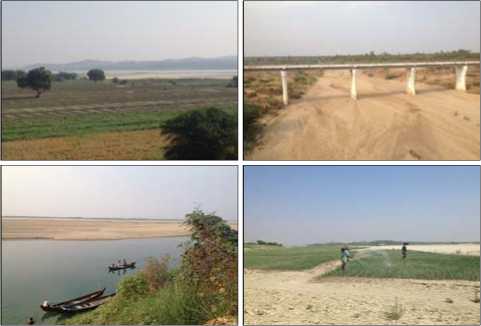
Fig. 7. Study area photographs during ground truth an field verification in central dry zone area of Myanmar
Список литературы Food vulnerability analysis in the central dry zone of Myanmar
- FAO: FAOSTAT on the UN, Myanmar, Food and Agriculture Organization of the United Nations (FAO) . -URL: http://faostat.fao.org/CountryProfiles/Country_Profile/Direct.aspx?lang=en&area=28.
- United Nations Commission on Sustainable Development . -URL: https://sustainabledevelopment.un.org/csd.html.
- JICA. The development study on sustainable agricultural and rural development for poverty reduction programme in the central dry zone of the Union of Myanmar. Final report. -Report No: RD JR 10-502. -Japan International Cooperation Agency, 2010.
- World Bank. Myanmar -Ayeyarwady integrated river basin management project . -Report No: PAD987. -Washington, DC: World Bank Group, 2014. -URL: http://documents.worldbank.org/curated/en/347681468279901640/Myanmar-Ayeyarwady-Integrated-River-Basin-Management-Project.
- Haggblade, S. A strategic agricultural sector and food security diagnostic for Myanmar/S. Haggblade, D. Boughton, G. Denning, R. Kloeppinger-Todd, K.M. Cho, S. Wilson, L.C.Y. Wong, Z. Oo, T.M. Sandar, N.E.M.A. Wai, N.W. Win. -Michigan, USA: Michigan State University; Yangon, Myanmar: Myanmar Development Resource Institute -Centre for Economic and Social Development (MDRI-CESD). -2015. -URL: http://fsg.afre.msu.edu/Myanmar/myanmar_agricultural_sector_diagnostic_july_2013.pdf.
- LIFT dry zone programme framework . -URL: https://www.lift-fund.org/sites/lift-fund.org/files/uploads/Dry_Zone/Dry_Zone_programme_framework_-_24_April_15.pdf.
- Boori, M.S. Vulnerability analysis on Hyderabad city, India/M.S. Boori, K. Choudhary, A. Kupriyanov//Computer Optics. -2016. -Vol. 40, Issue 5. -P. 752-758. - DOI: 10.18287/2412-6179-2016-40-5-752-758
- Boori, M.S. Avaliação de impacto ambiental e gestão dos recursos naturais no estuário Apodi Mossoró, nordeste do Brasil/M.S. Boori. -Tese de Doutorado. -Tese N0 29/PPGG. -Natal-RN, Brazil: Universidade Federal do Rio Grande do Norte, 2011. -URL: https://repositorio.ufrn.br/jspui/bitstream/123456789/18360/1/MukeshSB_TESE.pdf.
- Widayani, P. Application of geographically weighted regression for vulnerability area mapping of Leptospirosis in Bantul District/P. Widayani, T. Gunawan, P. Danoedoro, S.J. Mardihusodo//Indonesian Journal of Geography. -2016. -Vol. 48, Issue 2. -P. 168-177. - DOI: 10.22146/ijg.17601
- WFP (World Food Programme). Food security assessment in the Dry Zone Myanmar . -URL: http://documents.wfp.org/stellent/groups/public/documents/ena/wfp234780.pdf.
- Boori, M.S. Monitoring land use/cover change detection through remote sensing and GIS techniques in Eastern Siberia, Russia/M.S. Boori, K. Choudhary, A. Kupriyanov, A. Sugimoto, V. Kovelskiy//SGEM2016 Conference Proceedings. -2016. -Vol. 2. -P. 971-978. - DOI: 10.5593/SGEM2016/B22/S10.124
- Boori, M.S. Natural and Environmental vulnerability analysis through remote sensing and GIS techniques: A case study of Indigirka River basin, Eastern Siberia, Russia/M.S. Boori, K. Choudhary, A. Kupriyanov, A. Sugimoto, M. Evers//Proceedings of SPIE. -2016. -Vol. 10005. -100050U. - DOI: 10.1117/12.2240917

